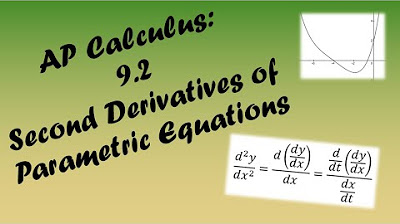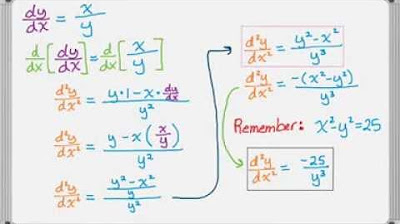Second Derivative of Parametric Equations with Example
TLDRThis video explains how to find the second derivative of parametric equations. It begins by reviewing the first derivative (dy/dx), emphasizing its dependence on the parameter t. To find the second derivative (d²y/dx²), the video walks through using the chain rule and provides a step-by-step example. The example illustrates the process with given functions, including simplification techniques. Overall, it highlights the importance of memorizing key steps and methods for correctly finding the second derivative in parametric contexts.
Takeaways
- 📊 The video discusses how to find the second derivative of a set of parametric equations.
- 🔗 The parametric equations are defined as X = F(T) and Y = G(T).
- 📈 The first derivative dy/dx is calculated as (dy/dt) / (dx/dt) or G'(T) / F'(T).
- 🧩 The first derivative dy/dx is a function of T, which is crucial for finding the second derivative.
- 🔄 To find the second derivative d²y/dx², you need to take the derivative of dy/dx with respect to X.
- 🧮 Applying the chain rule, d²y/dx² = (d/dt of dy/dx) / (dx/dt).
- 🔢 Example provided: X = T³ + T² and Y = 7T² - 4.
- 📝 First derivatives for the example: dx/dt = 3T² + 2T and dy/dt = 14T.
- 🧮 The first derivative dy/dx for the example simplifies to 14 / (3T + 2).
- ➗ For the second derivative, the derivative of 14 / (3T + 2) with respect to T is computed and then divided by dx/dt.
- 🔍 The final second derivative for the example is -42 / (T * (3T + 2)³).
- 📚 Key tip: Simplify expressions as much as possible to make the calculations easier.
Q & A
What is the main topic of the video?
-The main topic of the video is finding the second derivative of a set of parametric equations.
What are the parametric equations given in the video?
-The parametric equations given are X = F(T) and Y = G(T).
How is the first derivative of a parametric function represented?
-The first derivative is represented as dy/dx, which is the derivative of Y with respect to X.
What is the chain rule and how is it applied in finding the first derivative of parametric equations?
-The chain rule is a method in calculus for differentiating composite functions. In the context of parametric equations, it is applied to find dy/dx by differentiating Y with respect to T (dy/dt) and multiplying by the derivative of X with respect to T (dx/dt).
What is the alternative notation for dy/dx in terms of the functions F and G?
-The alternative notation for dy/dx is G'(T)/F'(T), where G'(T) is the derivative of G with respect to T and F'(T) is the derivative of F with respect to T.
Why is it important to recognize that dy/dx is a function of T?
-Recognizing that dy/dx is a function of T is important because it affects how we find the second derivative, as we need to apply the chain rule again to differentiate dy/dx with respect to T.
What is the process for finding the second derivative of Y with respect to X?
-The process involves differentiating dy/dx with respect to T, which involves applying the chain rule and then dividing by dx/dt.
In the example given, what are the expressions for X and Y in terms of T?
-In the example, X is given by T cubed plus T squared, and Y is given by 7T squared minus 4.
What is the recommended approach to finding dy/dx in the example provided?
-The recommended approach is to find dy/dt first, then dx/dt, and then divide dy/dt by dx/dt to find dy/dx.
How is the second derivative simplified in the example?
-The second derivative is simplified by factoring out a T from dx/dt, rewriting the expression, and then combining terms to simplify the final result.
What is the final expression for the second derivative in the example?
-The final expression for the second derivative in the example is negative 42 over T times (3T + 2) squared.
Outlines
📚 Introduction to Finding Second Derivatives of Parametric Equations
This paragraph introduces the topic of the video, which is about calculating the second derivative of parametric equations. It explains the importance of first finding the first derivative, denoted as dy/dx, using the chain rule and simplifying the notation to G'(T)/F'(T) or Y'(T)/X'(T). The paragraph emphasizes the function of T in the derivatives and sets the stage for the method to find the second derivative by differentiating dy/dx with respect to T and simplifying the expression.
🔍 Detailed Process of Calculating the Second Derivative
The second paragraph delves into the detailed process of finding the second derivative of a set of parametric equations. It provides an example with specific functions for X and Y, guiding the viewer through the steps of finding DX/DT and DY/DT first. The paragraph illustrates the calculation of the first derivative dy/dx by dividing DY/DT by DX/DT and simplifying the expression. It then explains how to find the second derivative by differentiating dy/dx with respect to T, applying the chain rule, and simplifying the result. The summary includes the final expression for the second derivative and offers advice on memorizing the process for correct application.
Mindmap
Keywords
💡Parametric Equations
💡First Derivative
💡Chain Rule
💡Second Derivative
💡Function of T
💡Simplification
💡Power Rule
💡Derivative with respect to T
💡Differential Notation
💡Example Calculation
Highlights
Introduction to finding the second derivative of a set of parametric equations.
Parametric equations are given as X = F(t) and Y = G(t).
Finding the first derivative dy/dx involves applying the chain rule.
dy/dx can be expressed as dy/dt divided by dx/dt.
Alternative notations for dy/dx include G'(t)/F'(t) or Y'(t)/X'(t).
The first derivative is a function of t, which is crucial for finding the second derivative.
The second derivative involves differentiating dy/dx with respect to t.
The chain rule is used again to account for the dependency on t.
The second derivative is expressed as d²y/dx² = d/dt(dy/dx) / dx/dt.
Example provided to demonstrate the process of finding derivatives.
Example equations: X = t³ + t² and Y = 7t² - 4.
Finding dx/dt and dy/dt is recommended before calculating dy/dx.
Simplifying expressions by factoring out common terms is important.
The second derivative is found by differentiating dy/dx with respect to t and dividing by dx/dt.
Simplification techniques are used to make the final expression more manageable.
Final expression for the second derivative is given in the example.
Emphasis on memorizing the process to ensure correct calculations.
Conclusion and wish for good luck in applying the method.
Transcripts
Browse More Related Video

AP Calculus BC Lesson 9.2

Second derivatives (implicit equations): find expression | AP Calculus AB | Khan Academy

Implicit Differentiation Second Derivative Trig Functions & Examples- Calculus

Second Derivative of Implicit Function

Implicit Differentiation - Find The First & Second Derivatives

Implicit Differentiation
5.0 / 5 (0 votes)
Thanks for rating: